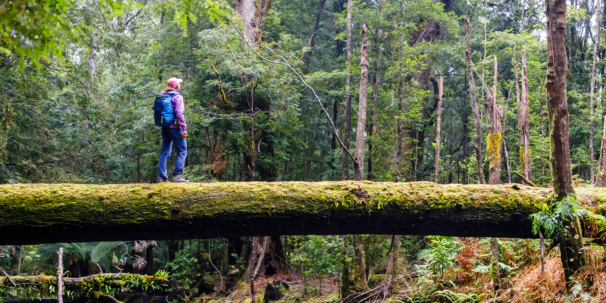Everything you need to know about the Australian Bush
The Australian bush is a lush landscape filled with native animals and plants. Learn more about this ecological wonder that Aussies hold so dear.

If you’ve never visited Australia, you may have never heard of the Australian bush. But for locals, the bush is a treasured landscape that’s teeming with Australiana. From the koalas to the crocs, the Australian bush just outside the big cities is an ecological wonder.
Here, we’re sharing everything you need to know about the Australian bush – from how it’s different to the Australian outback to the native plants and animals you’ll find there.
What is the Australian bush?
Sometimes confused with the Australian outback, the Australian bush is a colloquial term used among Australians to describe the backwoods or hinterland areas that are just outside the coastal areas of Australia.
In fact, many Australians understand “the bush” as more of a feeling than a specific place. It’s well-understood for locals but many non-Australians may not have any idea what people are talking about when they hear “Australian bush”.
Simply put, the Australian bush is the forested, “bushy’ area of Australia and is the home of many native Australian animals and plants. People often go camping or hiking in the bush while some even live in the bush areas of Australia on large plots of land.
The Australian outback, on the other hand, refers to the dry, arid interior landscapes of Australia. This reddish, desert is considered the outback while the Australian bush is full of lush, green flora and native fauna.
Australian Bush Regions
The Australian Bush refers to any remote forested region. To give you an idea of where the bush is located throughout Australia, there are 37 bush reserves protected by Bush Heritage Australia which include:
- Currumbin Valley in Queensland
- Burrin Burrin in New South Wales
- Boolcoomatta in South Australia
- Nardoo Hills in Victoria
- Chereninup Creek in Western Australia
- South Esk Pine in Tasmania
However, these reserves make up just a small fraction of the stunning bush hinterlands throughout Australia.
Characteristics of the Australian Bush
- Remote, located outside of the inner city
- A dense, forested landscape within a mountainous terrain
- Temperate climate
- Bushfires are common in the summers
- Filled with native Australian animals and plants






Native Australian Animals
There are countless animal species that live in the Australian bush. Many native Australian animals like snakes, spiders, kangaroos and crocodiles can be found there. Some of the most common animals you might see on a bushwalk include:
- Australian bush turkeys
- Thorny devils
- Wombats
- Kangaroos
- Koalas
- Kookaburras
Australian Bush Turkeys
Turkeys probably aren’t the first animal you think of when Australia comes to mind but, Australians know that they’re one of the most common animals you’ll find meandering through the bush. With their bright red and yellow heads, Australian bush turkeys are found mostly in the bush regions of southern Queensland and northern New South Wales.
Wombats
Wombats are iconic Australian bush animals that belong to the marsupial family. Expert diggers and adaptable to survive intense bushfires and environmental changes, wombats (or at least their close relatives) have been living in Australia for millennia.
Thorny Devils
These spiky lizards are only found in the Australian bush and while they don’t look particularly cuddly, these animals are mostly harmless. Of course, you wouldn’t want to accidentally step on one but thorny devils aren’t poisonous and spend their days eating mostly ants.
Kangaroos
Kangaroos are undoubtedly the most quintessential Australian animal and these marsupials can be found all over the Australian bush. They’re also known for living in the hostile Australian outback as well. Using their powerful legs and tails, kangaroos can jump great distances. And in the wild, they’re much more dangerous than you’d think. So, if you see one, it’s best to marvel from afar.
Koalas
An Australian icon – the koala lives in the gum tree bush areas of Queensland, New South Wales and Victoria. Eating and sleeping most of the days way up in the treetops, koalas are slowly becoming more endangered but can still be found throughout much of the Australian bush.
Kookaburras
With their famous laughter-like bird call, kookaburras are native Australian birds who are found all over Australia – in cities, hinterlands and in the outback. Listen closely and you’re sure to hear them in the early mornings and at dusk.
Native Australian Plants
In addition to the incredible animals that live in the bush, you’ll find countless native Australian plants in this lush landscape as well. While there are too many Australian bush plants to name them all, some of the most iconic include:
- Gum Trees (Eucalyptus)
- Wattles (Acacia)
- Bottlebrushes (Callistemon)
Gum Tree (Eucalyptus)
Gum trees are the home and the food source of Australian koalas and they make up a solid chunk of the plant life found in the Australian bush. There are over 700 species of eucalyptus in Australia with many different floral expressions that attract various birds and bees.
Wattle (Acacia)
There are over 1000 species of acacia found in Australia alone. These fast-growing shrubs create the perfect home for many native birds and their bright yellow flowers attract bees. You’ll see these humble yet beautiful plants all throughout the Australian bush and hinterland.
Fun fact: The acacia is the national flower of Australia.
Bottlebrush (Callistemon)
Known for its bottle-like shape and stunning red colour, bottlebrushes are hardy shrub plants that are sprinkled throughout the Australian bush. They provide food and shelter for native Australian animals such as possums, lizards and birds and they also make gorgeous additions to any bush flower bouquet.
Australian Bushfires
Another common characteristic of the Australian bush landscape is the reality of bushfires. Bushfires are Australian wildfires that are common in the hotter summer months. However, the effects of climate change seem to exacerbate the intensity of recent Australian bushfires.
Bushfire Causes
Bushfires are a natural part of the lifecycle of hinterland regions. In fact, indigenous Australians have detailed rituals surrounding bushfires and controlled burns that date back centuries.
Simply put, bushfires are caused when there’s the presence of the following:
- Dry fuel (dry shrubs, trees and leaves)
- Dry air
- Wind movement
- High temperatures
- Land slope
- Ignition source
Again, it’s natural for dried bushland to ignite during hot summers where the air is dry. However, climate change has made temperatures rise and caused long-lasting droughts. Therefore, climate change is almost certainly connected to more extreme weather including more intense bushfires.
Bushfire Prevention
Australians have systems in place to prevent bushfires as much as possible. Controlled burns and fire alleys are two of the most common ways Australians can keep these wildfires from getting out of hand.
By performing controlled burns, it rids the area of dried trees, shrubs and leaves which would otherwise be left as fuel for a potential out-of-control bushfire. Fire alleys are predetermined areas that are manually cleared of all dried fuel with the goal of stopping the spread of wildfires.
Read our entire blog post on Australian bushfires here.
Australian Bush and Climate Change
Climate change has a huge impact on the entire Australian continent and the Australian bush is no exception. We’ve already mentioned that Australian wildfires are exacerbated due to climate change with higher temperatures and extended droughts.
Additionally, climate change has a negative impact on the wildlife living in the bush and has given rise to many more endangered animals and plants in Australia. As bush habitats are destroyed not only by Australian bushfires but by rising temperatures in general, the bush itself is drier and less habitable for many native Australian plants and animals.
The good news is that there are plenty of conservation efforts going on in the Australian bush to help save this stunning landscape from further decline.
Australian Bush Conservation
Unfortunately, many native Australian animals who call the bush home are becoming endangered and even going extinct. Although estimates vary, there are currently around 300 endangered bush animals in Australia including the bandicoot, greater bilby and others.
To help endangered Australian animals, conservation efforts are in place to protect and restore bushland habitats to promote the proliferation of these incredible animal species. Much of the Australian bush is also preserved as national parks sprinkled all around the country.
By doing more to control Australian wildfires and leave these hinterlands untouched, conservation in the Australian bush is a huge piece to the puzzle in the fight against climate change.




Final thoughts
The Australian bush is a stunning landscape that is deeply connected to the Australian people. Teeming with native Australian animals and plants, it’s a chance for Aussies to return to nature.
From the laughter of a kookaburra to the beauty of the acacias and spread out in the more remote regions of Australia, the hinterlands of the Australian bush is filled with stunning sights and sounds.
Although climate change and Australian wildfires threaten this incredible habitat, conservation efforts are in place to preserve these pure, natural spaces.
Join FutureLearn to learn more about Australian bushfires, climate change and Australian ecology today!




